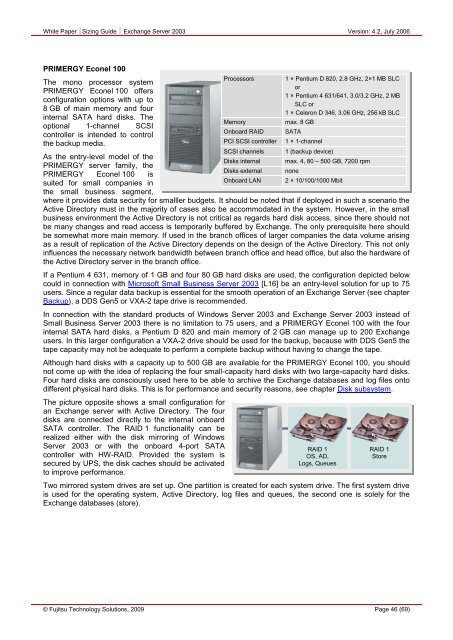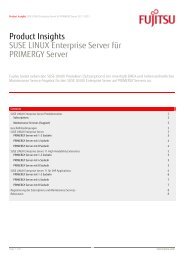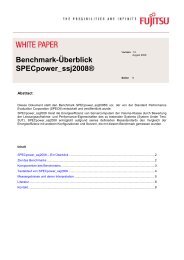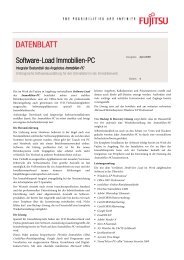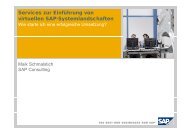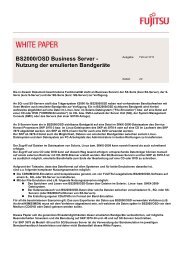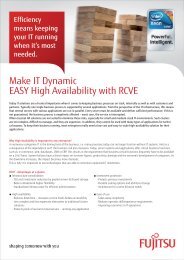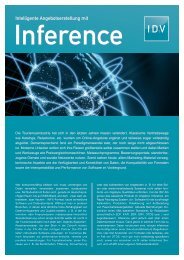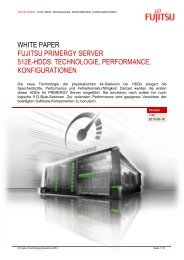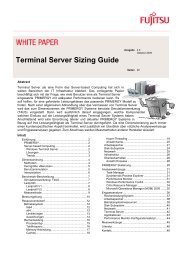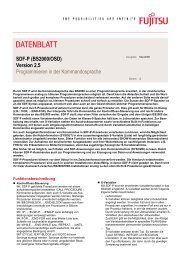Sizing Guide Exchange Server 2003 - Fujitsu
Sizing Guide Exchange Server 2003 - Fujitsu
Sizing Guide Exchange Server 2003 - Fujitsu
Create successful ePaper yourself
Turn your PDF publications into a flip-book with our unique Google optimized e-Paper software.
White Paper <strong>Sizing</strong> <strong>Guide</strong> <strong>Exchange</strong> <strong>Server</strong> <strong>2003</strong> Version: 4.2, July 2006<br />
PRIMERGY Econel 100<br />
The mono processor system<br />
PRIMERGY Econel 100 offers<br />
configuration options with up to<br />
8 GB of main memory and four<br />
internal SATA hard disks. The<br />
optional 1-channel SCSI<br />
controller is intended to control<br />
the backup media.<br />
As the entry-level model of the<br />
Disks internal max. 4, 80 – 500 GB, 7200 rpm<br />
PRIMERGY server family, the<br />
Disks external none<br />
PRIMERGY Econel 100 is<br />
suited for small companies in<br />
Onboard LAN 2 × 10/100/1000 Mbit<br />
the small business segment,<br />
where it provides data security for smalller budgets. It should be noted that if deployed in such a scenario the<br />
Active Directory must in the majority of cases also be accommodated in the system. However, in the small<br />
business environment the Active Directory is not critical as regards hard disk access, since there should not<br />
be many changes and read access is temporarily buffered by <strong>Exchange</strong>. The only prerequisite here should<br />
be somewhat more main memory. If used in the branch offices of larger companies the data volume arising<br />
as a result of replication of the Active Directory depends on the design of the Active Directory. This not only<br />
influences the necessary network bandwidth between branch office and head office, but also the hardware of<br />
the Active Directory server in the branch office.<br />
If a Pentium 4 631, memory of 1 GB and four 80 GB hard disks are used, the configuration depicted below<br />
could in connection with Microsoft Small Business <strong>Server</strong> <strong>2003</strong> [L16] be an entry-level solution for up to 75<br />
users. Since a regular data backup is essential for the smooth operation of an <strong>Exchange</strong> <strong>Server</strong> (see chapter<br />
Backup), a DDS Gen5 or VXA-2 tape drive is recommended.<br />
In connection with the standard products of Windows <strong>Server</strong> <strong>2003</strong> and <strong>Exchange</strong> <strong>Server</strong> <strong>2003</strong> instead of<br />
Small Business <strong>Server</strong> <strong>2003</strong> there is no limitation to 75 users, and a PRIMERGY Econel 100 with the four<br />
internal SATA hard disks, a Pentium D 820 and main memory of 2 GB can manage up to 200 <strong>Exchange</strong><br />
users. In this larger configuration a VXA-2 drive should be used for the backup, because with DDS Gen5 the<br />
tape capacity may not be adequate to perform a complete backup without having to change the tape.<br />
Although hard disks with a capacity up to 500 GB are available for the PRIMERGY Econel 100, you should<br />
not come up with the idea of replacing the four small-capacity hard disks with two large-capacity hard disks.<br />
Four hard disks are consciously used here to be able to archive the <strong>Exchange</strong> databases and log files onto<br />
different physical hard disks. This is for performance and security reasons, see chapter Disk subsystem.<br />
The picture opposite shows a small configuration for<br />
an <strong>Exchange</strong> server with Active Directory. The four<br />
disks are connected directly to the internal onboard<br />
SATA controller. The RAID 1 functionality can be<br />
realized either with the disk mirroring of Windows<br />
<strong>Server</strong> <strong>2003</strong> or with the onboard 4-port SATA<br />
controller with HW-RAID. Provided the system is<br />
secured by UPS, the disk caches should be activated<br />
to improve performance.<br />
Processors 1 × Pentium D 820, 2.8 GHz, 2×1 MB SLC<br />
or<br />
1 × Pentium 4 631/641, 3.0/3.2 GHz, 2 MB<br />
SLC or<br />
1 × Celeron D 346, 3.06 GHz, 256 kB SLC<br />
Memory max. 8 GB<br />
Onboard RAID SATA<br />
PCI SCSI controller 1 × 1-channel<br />
SCSI channels 1 (backup device)<br />
RAID 1<br />
OS, AD,<br />
Logs, Queues<br />
RAID 1<br />
Store<br />
Two mirrored system drives are set up. One partition is created for each system drive. The first system drive<br />
is used for the operating system, Active Directory, log files and queues, the second one is solely for the<br />
<strong>Exchange</strong> databases (store).<br />
© <strong>Fujitsu</strong> Technology Solutions, 2009 Page 46 (69)


